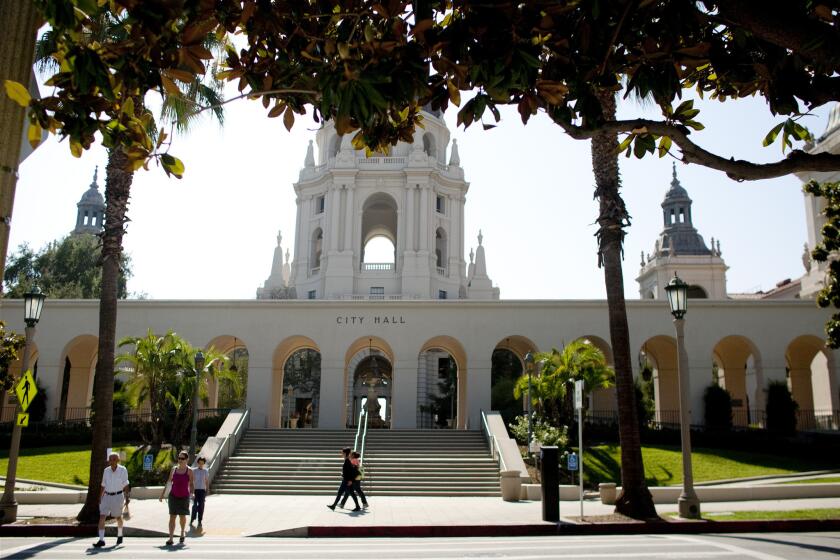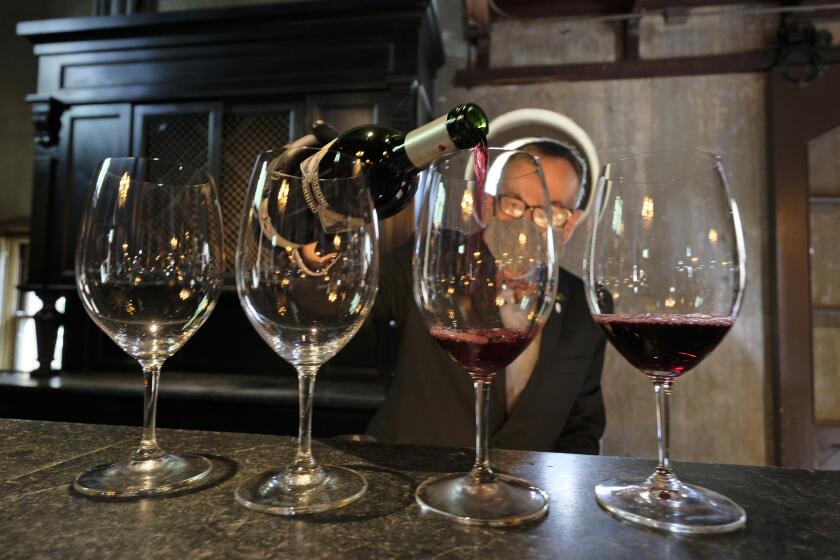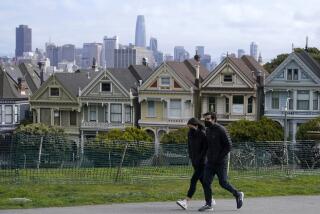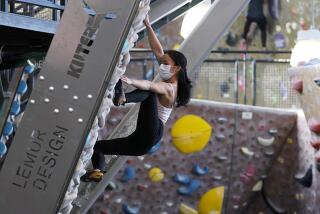Bay Area outdoor dining reopens again, but no one knows if pandemic will cooperate
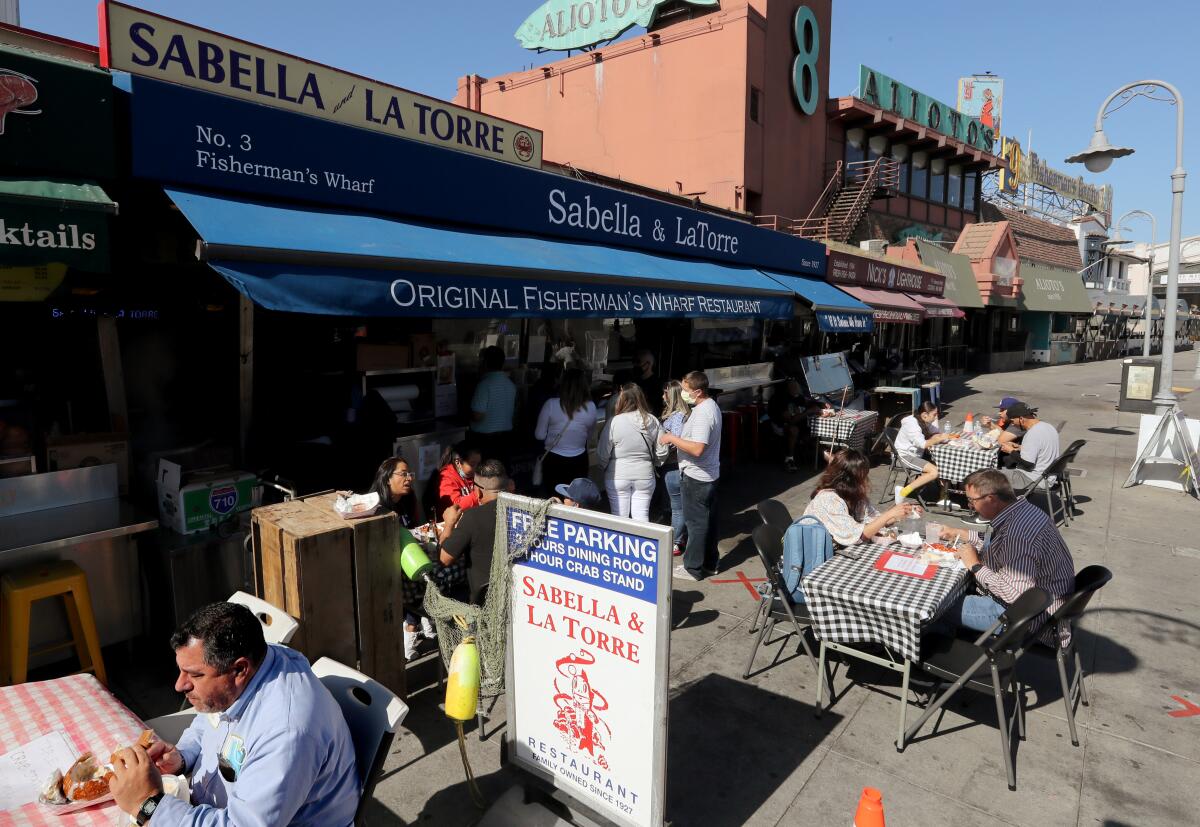
SAN FRANCISCO — The San Francisco Bay Area, a destination for foodies and wine drinkers across California and abroad, is resuming outdoor dining, even as the pandemic continues to threaten the region.
The state’s relaxation of stay-at-home orders could provide a big boost to the region’s tourism industry, with some caveats.
Like much of California, the Bay Area remains a tapestry of limits on social gatherings, a product of individual counties setting their own rules based on state guidelines, which can be hard for people outside the region and even inside to follow. Though the area’s county health officials have been more unified than their counterparts in Southern California, the re-openings announced Monday could change depending on infection rates caused by new strains of the virus.
Travelers will still face quarantine requirements when entering San Francisco and Santa Clara counties, officials there said. But those loosely enforced rules may not necessarily be in effect elsewhere.
Learning that the state stay-at-home order would be lifted, Cynthia Ariosta, managing partner of an upscale pizzeria in Napa Valley, said she “jumped up and down for joy.” Then she got to work.
Ariosta’s Pizzeria Tra Vigne was one of 50 Bay Area restaurants and wineries that joined together to sue Gov. Gavin Newsom last week over an order that shut down outdoor dining and wine tastings across most of the state.
The Wine Country Coalition for Safe Reopening claimed in the suit that their constitutional rights were being trampled as they slipped into financial ruin. Pizzeria Tra Vigne lost about $1 million in sales last year, Ariosta said. A staff that was 50 strong last March dwindled to about eight, she said.
Many businesses across the region are expected to reopen soon but with a more skeptical eye toward what happens next.
San Francisco and Santa Clara counties will permit restaurants to reopen for outdoor dining and hair stylists and barbers to resume limited service. Many Bay Area counties announced the same reopenings, although San Francisco won’t allow outdoor dining until Thursday. Curfew and travel quarantine requirements will remain in place, San Francisco officials said.
During an online news conference, San Francisco Mayor London Breed urged residents to continue to wear masks, practice social distancing and frequently wash their hands as the city reopens.
“Just keep in mind that this is not an open door for us to all of a sudden let our hair down and do whatever we want,” Breed warned.
James R. Williams, the Santa Clara County counsel, had similar cautionary words during a separate online news conference.
“We are still nowhere out of the woods,” Williams said. “We still have a much higher level of hospitalizations and cases here in Santa Clara County than we did going into the Thanksgiving break.”
Similar to San Francisco, Santa Clara has a travel directive requiring visitors from more than 150 miles away to quarantine upon entering its jurisdiction, and it has effectively reduced travel, Williams said.
Californians are being asked to go no farther than 120 miles from home. Here are places that keep you within that limit.
Newsom on Monday announced the end of regional stay-at-home orders, based on projections that conditions in hospitals were improving. The decision came under fire from some public health advocates and nurses, but it brought some hope to hard-hit business owners, including in Napa County.
There, the county allowed outdoor operations to immediately reopen with safety precautions after the lifting of the state order, said Janet Upton, spokeswoman for the county.
“This is what we wanted,” Ariosta said. “We wanted outdoor dining and wine tasting for the sake of our businesses and our employees. So our first order of business this morning was, OK, we need to get people back to work.”
San Francisco and other parts of the Bay Area depend on hotel tax revenues and other tourism spending to pay for services now facing deep budget cuts because of the pandemic. Still, the region has been careful not to reopen so quickly that its hospitals could become overwhelmed.
In San Francisco, the city will continue to keep in place a curfew prohibiting nonessential businesses and gatherings from 10 p.m. to 5 a.m. in addition to the quarantine order for travelers.
The reopening will permit all personal services, including massage and tattoo parlors, to resume with mask requirements, allow zoos and museums to reopen outdoors and hotels to open to tourists. City officials said they were equipped to be vaccinating many more people but continue to have an inadequate supply of the vaccine.
San Francisco experienced a scare last week when officials reported the city could run out of vaccine by Thursday, in part because of state warnings about a suspect batch of Moderna doses. After those doses were deemed safe, the city was able to continue vaccinations with no lapse.
Dr. Grant Colfax, the city’s public health director, said his department is set to receive 10,575 doses this week and they are “ready to go out the door right now.”
“We need more vaccine,” he said.
He said the entire city so far has received 127,000 doses and administered 59,000 doses. The remaining 59,000 doses already have been scheduled to be given to people needing first and second shots, he said.
Asked why the city was reopening in the presence of new, more infectious variants of the virus, Colfax said “there is no reason to panic” about the strains as long as people continue to mask and follow other precautions.
In Santa Clara, Williams cited Southern California, which is still fighting high case loads and at least one variant of the virus, as one of the reasons the travel directive was still needed.
Sonoma County wineries are reopening to an altered landscape
Because of the uncertain risk of contagion, residents should “double down on being really strict about following the public health guidance” and avoiding travel, he said.
Santa Clara County also will continue to limit hotels to essential lodging, prohibiting the rental of rooms for tourism or other leisure purposes. By contrast, San Francisco will allow hotel lodging to resume.
San Francisco’s ICU capacity remains stable at 26%, and the infection rate in the city has fallen to below one, Breed said.
San Francisco began preparing for a vaccine rollout in August, ordering the refrigerators needed to keep doses at their required temperature, she said, but vaccinations continue to be limited by supply. Healthcare workers and people 65 and older in San Francisco are now entitled to receive the vaccine.
As soon as more doses come in, “they will be out on the street in someone’s arm so we can get things rolling again,” Breed said.
More to Read
Sign up for Essential California
The most important California stories and recommendations in your inbox every morning.
You may occasionally receive promotional content from the Los Angeles Times.
